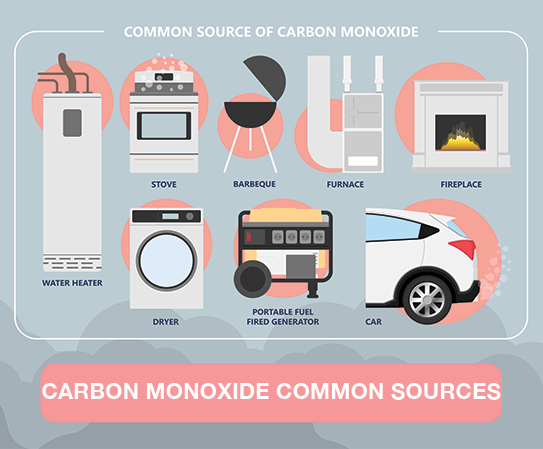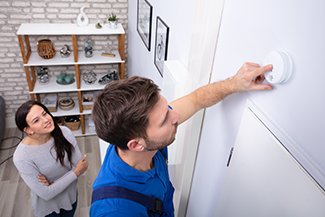Where Should I Install Carbon Monoxide Detectors?
Where Should I Install CO Detectors?
If you heat your home with a gas furnace or use other gas appliances at home, you must install, life-saving, carbon monoxide detectors.
 The Danger: You can’t see or smell carbon monoxide, which is a potential byproduct of burning fossil fuels.
The Danger: You can’t see or smell carbon monoxide, which is a potential byproduct of burning fossil fuels.
The Centers for Disease Control and Prevention's (CDC) Frequently Asked Questions Regarding Carbon Monoxide Poisoning answers these key questions:
Where is CO found?
CO is found in fumes produced any time you burn fuel in cars or trucks, small engines, stoves, lanterns, grills, fireplaces, gas ranges, or furnaces. CO can build up indoors and poison people and animals who breathe it.
What are the symptoms of CO poisoning?
The most common symptoms of CO poisoning are headache, dizziness, weakness, upset stomach, vomiting, chest pain, and confusion. CO symptoms are often described as “flu-like.” If you breathe in a lot of CO it can make you pass out or kill you. People who are sleeping or drunk can die from CO poisoning before they have symptoms.
Who is at risk from CO poisoning?
Everyone is at risk for CO poisoning. Infants, the elderly, people with chronic heart disease, anemia, or breathing problems are more likely to get sick from CO. Each year, more than 400 Americans die from unintentional CO poisoning not linked to fires, more than 20,000 visit the emergency room, and more than 4,000 are hospitalized.
That being said, it would behove you to make sure your home has at the very least, one carbon monoxide detector to alert you of the presence of gas.
Ideally you'll install a CO detector on every floor of the house and inside every bedroom.

Follow these safety guidelines:
- If you install only one carbon monoxide detector, put it on the same floor as the bedrooms so it can alert your family to wake up in case levels of the gas reach an unhealthy point. Better: Place a detector on every floor of the house or in every bedroom.
- Follow the manufacturer’s instructions for where to place the detector on the wall.
- A rule of thumb: Place CO detectors at a minimum of 5-feet above the finish floor where they will stay dust-free and where children and pets won’t bother them.
- Keep your detectors at least 15 feet away from a gas stove or oven, which may emit a small amount of carbon monoxide on startup.
- Detectors don’t operate properly in humid areas like the bathroom.
- Replace the batteries in your alarms at least once a year (twice is better) and test them often.
- Properly maintain your gas appliances, including the furnace and stove. Same goes for devices that use gasoline.
- Know the warning signs of too much carbon monoxide in the house before you feel the symptoms: Stuffy, stale air; condensation on windows; yellow burner flames on the stove; and fluttering or extinguishing pilot lights.
- If you see the signs or your CO alarm sounds, immediately open doors and windows, turn off suspect appliances, exit the home, and call a natural gas contractor to inspect the equipment.
- If your garage is connected to your house, avoid idling your car. NEVER turn your car on if the garage door is closed. Car exhaust is a source of carbon monoxide.
###
Photo Credit
- Shutterstock
Related Content
- DIY FAQ: Inspect & Test Home Alarm Systems Regularly | #AlarmSystem
- DIY FAQ: How Can I Prevent Security-System False Alarms?
- DIY FAQ: What Are Some Tips For Buying And Installing Smoke Alarms?
- DIY FAQ: Where Should I Install Co Detectors?
- DIY FAQ: Rosie's Home Security Consumer Guide
- DIY FAQ: Where Should I Install Carbon Monoxide Detectors?
- DIY FAQ: Deadly Home Invasion: Radon
- DIY FAQ: What You Need To Know About Radon
Article Updated 10-25-21
